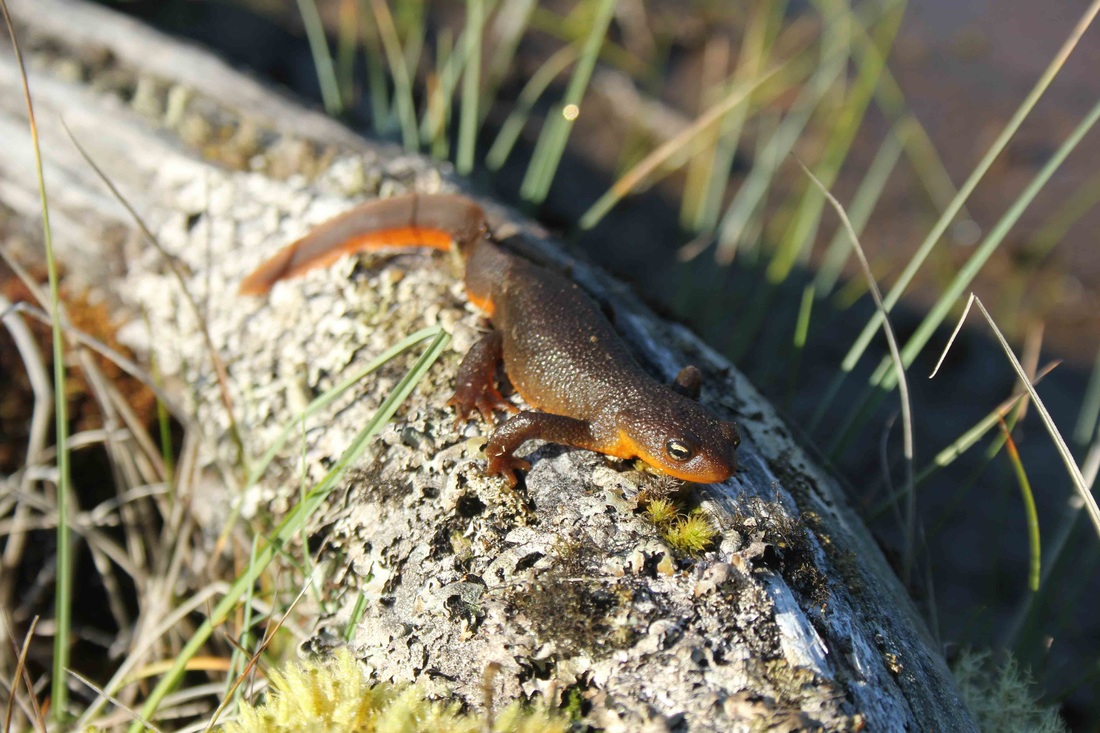Roughskin newt • Taricha granulosa
|
Identification
This distinctive salamander is two toned: dull grey to brown on top, and bright orange to yellow below. It has a fairly stocky shape, can reach nearly 22 cm long from nose to tail, and has rough, grainy skin — as per its common name. The gilled larvae are tan with black flecks on top, and pink underneath. Older larvae have one or two lines of small white dots along each side of the body. Unlike most other amphibians, the roughskin newt lays eggs singly instead of in clusters or strings. These individual eggs are scattered around breeding ponds, where they are well-hidden among vegetation. Click here for more photos of this species. |
Habitat & Range
The roughskin newt can be found in and around ponds, lakes, streams, and other wetlands while breeding in the spring. Some adults continue to live in wetlands through the summer or all year, while others migrate back to forested habitats — mostly older, mixed forests. There they can be found in and under decomposing logs and leaf litter, and in burrows formed by other animals. Unlike other salamanders, this species is active during the day as well as at night. It also is more active in wet weather. In winter the roughskin newt becomes inactive and hunkers down in moist, dark locations that do not freeze, such as under logs and underground.
This common amphibian can be found from sea level to 2700 m elevation, with a coastal range extending from southeastern Alaska to Santa Cruz county, California. There are also a few records from parts of the southern Rocky Mountains, though these populations may be from introductions of this species.
Intriguing Info
The roughskin newt's vivid underside is displayed as a warning to potential predators when the animal is disturbed. This defensive pose consists of curving both its neck and tail up, to show off as much of the orange colouring as possible. The warning is not unwarranted: the roughskin newt's skin secretes tetrodotoxin, a neurotoxin that is most potent when consumed by predators but can also irritate human skin if touched. This toxin, which is also found in pufferfish alongside numerous other animals, is strong enough to kill predators that do not heed the newt's warning colouration. The common garter snake appears to be an exception, making it one of the newt's few predators.
The roughskin newt preys upon insects, slugs, worms, and other organisms — including amphibian eggs and larvae, even ones of its own species. The egg-laying technique of scattering individual eggs around a breeding habitat may help prevent breeding newts from eating all the newly-laid eggs.
The roughskin newt can be found in and around ponds, lakes, streams, and other wetlands while breeding in the spring. Some adults continue to live in wetlands through the summer or all year, while others migrate back to forested habitats — mostly older, mixed forests. There they can be found in and under decomposing logs and leaf litter, and in burrows formed by other animals. Unlike other salamanders, this species is active during the day as well as at night. It also is more active in wet weather. In winter the roughskin newt becomes inactive and hunkers down in moist, dark locations that do not freeze, such as under logs and underground.
This common amphibian can be found from sea level to 2700 m elevation, with a coastal range extending from southeastern Alaska to Santa Cruz county, California. There are also a few records from parts of the southern Rocky Mountains, though these populations may be from introductions of this species.
Intriguing Info
The roughskin newt's vivid underside is displayed as a warning to potential predators when the animal is disturbed. This defensive pose consists of curving both its neck and tail up, to show off as much of the orange colouring as possible. The warning is not unwarranted: the roughskin newt's skin secretes tetrodotoxin, a neurotoxin that is most potent when consumed by predators but can also irritate human skin if touched. This toxin, which is also found in pufferfish alongside numerous other animals, is strong enough to kill predators that do not heed the newt's warning colouration. The common garter snake appears to be an exception, making it one of the newt's few predators.
The roughskin newt preys upon insects, slugs, worms, and other organisms — including amphibian eggs and larvae, even ones of its own species. The egg-laying technique of scattering individual eggs around a breeding habitat may help prevent breeding newts from eating all the newly-laid eggs.
References
IUCN SSC Amphibian Specialist Group. (2015). Taricha granulosa. The IUCN Red List of Threatened Species. Accessed 18/12/2015.
Roughskin Newt. B.C. Frogwatch Program. Ministry of Environment, Province of British Columbia. Accessed 18/12/2015.
Taricha granulosa (Skilton, 1849). In Klinkenberg, Brian. (Ed.) E-Fauna BC: Electronic Atlas of the Fauna of British Columbia. Lab for Advanced Spatial Analysis, Department of Geography, University of British Columbia, Vancouver. Accessed 18/12/2015.
Authors and editors of page
Kelly Fretwell (2015).
IUCN SSC Amphibian Specialist Group. (2015). Taricha granulosa. The IUCN Red List of Threatened Species. Accessed 18/12/2015.
Roughskin Newt. B.C. Frogwatch Program. Ministry of Environment, Province of British Columbia. Accessed 18/12/2015.
Taricha granulosa (Skilton, 1849). In Klinkenberg, Brian. (Ed.) E-Fauna BC: Electronic Atlas of the Fauna of British Columbia. Lab for Advanced Spatial Analysis, Department of Geography, University of British Columbia, Vancouver. Accessed 18/12/2015.
Authors and editors of page
Kelly Fretwell (2015).





